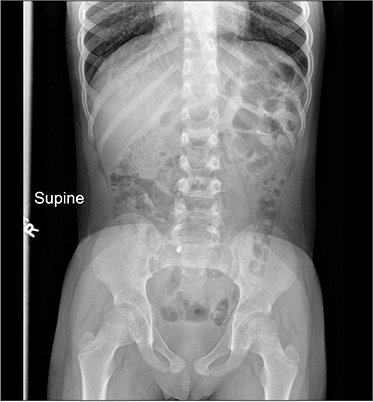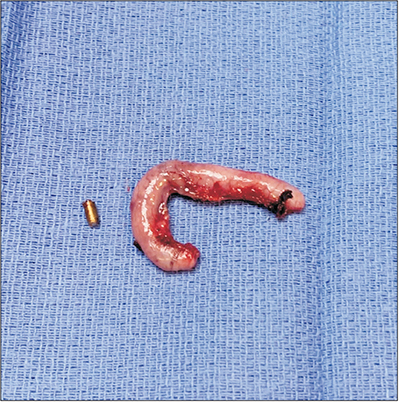Pediatr Gastroenterol Hepatol Nutr.
2019 Nov;22(6):619-623. 10.5223/pghn.2019.22.6.619.
Down the Rabbit Hole-Considerations for Ingested Foreign Bodies
- Affiliations
-
- 1University of South Florida, Tampa, FL, USA.
- 2Department of Pediatrics, University of South Florida College of Medicine, Tampa, FL, USA.
- 3Department of Pediatric Surgery, Johns Hopkins All Children's Hospital, St. Petersburg, FL, USA.
- 4Department of Pediatric Gastroenterology and Nutrition, Johns Hopkins All Children's Hospital, St. Petersburg, FL, USA. mwilsey1@jhmi.edu
- KMID: 2462105
- DOI: http://doi.org/10.5223/pghn.2019.22.6.619
Abstract
- We report the case of a seven-year-old boy with an ingested foreign body, which was retained within the appendix for a known duration of ten months, ultimately requiring appendectomy. The ingested foreign body was incidentally discovered by abdominal x-ray at an emergency room visit for constipation. Despite four bowel cleanouts, subsequent x-rays showed persistence of the foreign body in the right lower quadrant. While the patient did not have signs or symptoms of acute appendicitis, laparoscopic appendectomy was performed due to the risk of this foreign body causing appendicitis in the future. A small metallic object was found within the appendix upon removal. This case highlights the unique challenge presented by foreign body ingestions in non-verbal or developmentally challenged children and the importance of further diagnostic workup when concerns arise for potential retained foreign bodies.
Keyword
MeSH Terms
Figure
Reference
-
1. Kay M, Wyllie R. Pediatric foreign bodies and their management. Curr Gastroenterol Rep. 2005; 7:212–218.
Article2. Sukhotnik I, Klin B, Siplovich L. Foreign-body appendicitis. J Pediatr Surg. 1995; 30:1515–1516.
Article3. ASGE Standards of Practice Committee. Ikenberry SO, Jue TL, Anderson MA, Appalaneni V, Banerjee S, Ben-Menachem T, et al. Management of ingested foreign bodies and food impactions. Gastrointest Endosc. 2011; 73:1085–1091.
Article4. Balch CM, Silver D. Foreign bodies in the appendix. Report of eight cases and review of the literature. Arch Surg. 1971; 102:14–20.5. Wakeley CP. The position of the vermiform appendix as ascertained by an analysis of 10,000 cases. J Anat. 1933; 67(Pt 2):277–283.6. Sar S, Mahawar KK, Marsh R, Small PK. Recurrent appendicitis following successful conservative management of an appendicular mass in association with a foreign body: a case report. Cases J. 2009; 2:7776.
Article7. Louie M, Bradin S. Foreign body ingestion and aspiration. Pediatr Rev. 2009; 30:295–301.
Article8. Klingler PJ, Seelig MH, DeVault KR, Wetscher GJ, Floch NR, Branton SA, et al. Ingested foreign bodies within the appendix: a 100-year review of the literature. Dig Dis. 1998; 16:308–314.
Article9. Butterworth J, Feltis B. Toy magnet ingestion in children: revising the algorithm. J Pediatr Surg. 2007; 42:e3–e5.
Article
- Full Text Links
- Actions
-
Cited
- CITED
-
- Close
- Share
- Similar articles
-
- Unusual Gastrointestinal Complications due to Foreign Body Ingestion
- Gastrojejunal Fistula with Jejunal Rotation Caused by Two Ingested Magnets in a Child: A Case Report
- Anal Diseases from Ingested Foreign Bodies
- Ingested Foreign Body Trapped in the Appendix: A Case Report
- Spontaneous Passage of Gastrointestinal Foreign Bodies in Children




